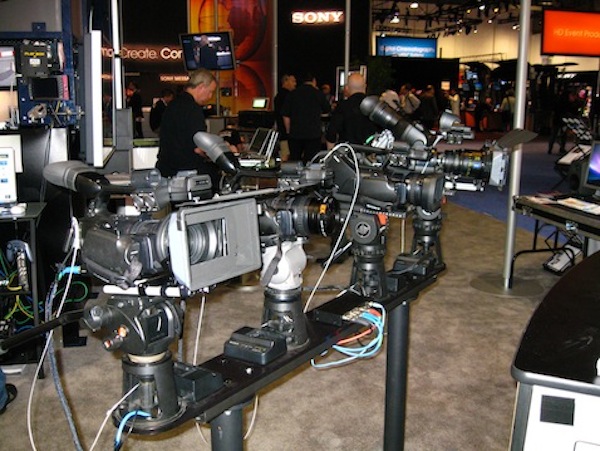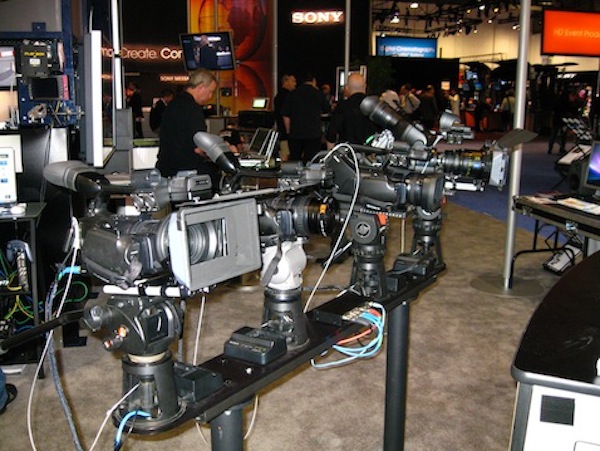
The final cover story I wrote for the late, lamented Millimeter magazine in September examined the ongoing transition of hour-long episodic TV production out of the film acquisition realm and into the digital universe-a transition resulting from a profound convergence of technological, business, and labor issues. (You can find the article here.) Following the last year’s slowdown in broadcast production, there are finally hints that things might speed up again in 2010, but broadcast production probably won’t return to its traditional levels for some time, if ever. Still, however fast or slow the production ball moves, there is no question the majority of hour-long episodic TV shows will be acquired using digital cameras going forward.
Thus, as I launch From the Trenches, it seems like a logical time to inquire how this paradigm shift is impacting various sectors of the industry, including camera sales and rental companies since it is largely through them that industry professionals get their hands on, and wrap their mind around, these new tools. Therefore, I recently dialed up a couple of industry veterans for a chat about the situation. This column, we start with input from Michael Bravin, the longtime Chief Technology Officer and HD guru at Band Pro Film & Digital in Burbank.
Bravin has been on both the rental and sales side of the industry in his time, and the first thing he told me was a major understatement, to say the least-“it’s been a tough year all around” for his industry (and everybody else, for that matter). Within that context, however, he suggested that major digital camera system providers like Band Pro have been able to hang in there because of the incremental rise in digital production specifically for broadcast and features, even as production overall slowed. In particular, he suggests, Band Pro’s business “remains solid” largely because of the proliferation of Sony’s F35 digital cinematography camera, which became widely available at around the time in which high-end TV productions were switching from film, or launching as digital shows to begin with.
Bravin emphasizes the serendipity of the F35, and other systems, becoming mature and available at exactly the time when productions needed such cameras. He points out that development of such new technology occurs long before the economic conditions into which that new technology will be inserted are known, and therefore, the ball gains a good head of steam that not even a later, big economic hit can fully disrupt.
“We’re seeing all sorts of paradigm shifts,” he says. “The story of the F35, for instance, was helped along because of the threat of (a SAG actor’s strike), causing producers to start signing AFTRA contracts, meaning they were now making video shows. They are now regularly using F35, (Panavision’s) Genesis, (Arri’s) D21 and some RED, as well, and that’s an unexpected boost for (digital television production). We all anticipated it happening, but the transition is probably a couple years ahead of where it would have been because of these factors. About a year and a half ago, I would have told you the increase in shows shot digitally would be driven just by the lowering of the cost of equipment and potential efficiencies in post-production, and that it would take about another two to three TV seasons to come to fruition, but (the labor issues) accelerated everything probably by a couple years.
“So, for our company, what is fortunate is that equipment you can buy or rent today to shoot with is stuff developed over one to two or more years ago, and is now coming to market. It was all developed in a different environment, when (manufacturers) had more money for development.”
Thus, to prognosticate what direction digital cinematography technology for broadcast is heading next, and what its role will be in the industry a year or two from now, is complicated. All sorts of other factors will play roles that were unanticipated when various systems began rolling out. Now, with immediate labor uncertainty over, experts anticipating at least a modest economic rebound in the new year, the ICG (Local 600) camera guild and producers making deals regarding so-called new media, and major technological improvements to not only cameras but various tapeless workflow solutions that were, even a year ago, fairly embryonic (Solid State recording, incorporation of digital still camera technologies, etc.), Bravin anticipates the rate of broadcast shows acquired digitally to rapidly increase, starting immediately. As a result, he’s optimistic about prospects for the camera sales and rental business, as long as such companies subtly, and logically, evolve their business models along with the technology and the economic landscape.
The bottom line, he says, is that producers want to reduce costs one way or another, and for better or worse, these factors combined have convinced them that digital acquisition is the best way to do that. There is a growing belief among those producers, he says, that going digital “will cost a bit more to rent the equipment, but overall, less to make each show. That’s the path they were on before the labor issues cropped up and they are still on that path, and even more committed to it than before. There is a collision of convergence between (the rise of computerized solutions) and the established way of doing things,” he adds.
And the digital path resulting from that collision is now, finally, taking shape.
If Michael is right, though, it means a lot of other things are going to have to change, particularly the post-production industry. Michael and many others I’ve talked to envision post people eventually “offering a business that comes to the set and wrangles data and does other things during production. Some of that is done now, but far more routinely than is done right now.”
“With RED and other approaches, if you use compact flash cards, those cards have to be backed up and converted into dailies that people can see,” he adds. “In the past, that process was usually done with tape at a post-production facility. Now, a (digital imaging technician) or data wrangler will do that on set, and right now, they are part of the camera department, not the post facility. But it might make more sense to say to the post facility, why don’t you do it? Give us dailies on set after we’re done shooting, rather than overnight. There are a few companies doing this now-turnkey operations offering both cameras and crews and post-production services, so productions can hire them as almost a service bureau. That approach will probably increase.”
As usual with the proliferation of radically new technologies in any sector, the arrival of high-end digital cameras, and now, various tapeless workflows being developed throughout the industry, have come ahead of the widespread practical education necessary to understand and seamlessly use such technologies and the various production pipeline options that come with them in the field. Guilds and camera sales and rental companies are taking up much of this slack with all sorts of seminars, events, classes, and online education across the world, of course, but even these offerings can’t possibly keep up with the insatiable demand. And more importantly, the pressing need to offer that education to begin with, by definition, changes the nature of the companies offering it, compared to how they used to do business.
“You move to a tapeless workflow, so obviously, you eliminate something and add other things and you end up with all sorts of new training and expertise to go with that stuff,” Bravin explains. “So providing training changed our business. In our case, Band Pro jumped deep into it in recent years. There are folks selling boxes and doing low-cost Internet sales, and then there are those selling the technology and then doing training and after-sales support. We got into education because it helps our sales business and serves the industry, but it is a challenge. And we have new upcoming growth areas that will be big deals in the next 12 to 18 months, with Solid State and the incorporation of digital SLR (still) cameras into the mix, and lots of other things, and those now need to be addressed (with educational opportunities). It has to be offered-after all, you don’t save money (with digital acquisition) unless you know what you are doing.”
Bravin adds that another, related change for his industry is the fact that productions often want the sales or rental house that supplies their cameras and related equipment to design the entire workflow for particular shows for which they are buying or renting that equipment. “Those productions want to use (digital cameras and workflows) but they don’t always know how to finance it, how to train people, how to design the workflow,” he says. “They are asking us to do these things, and again, that changes our traditional way of doing things.”
Bravin says Band Pro believes it has to offer education and related services, in addition to its traditional sales work, because in the current environment, “adding value” is crucial to staying viable. Still, he and many others are concerned about how the transition in their industry will shake out. My next column will continue this discussion with a representative from a well-known camera rental company that has long been on the front lines of the industry’s transition to HD.

